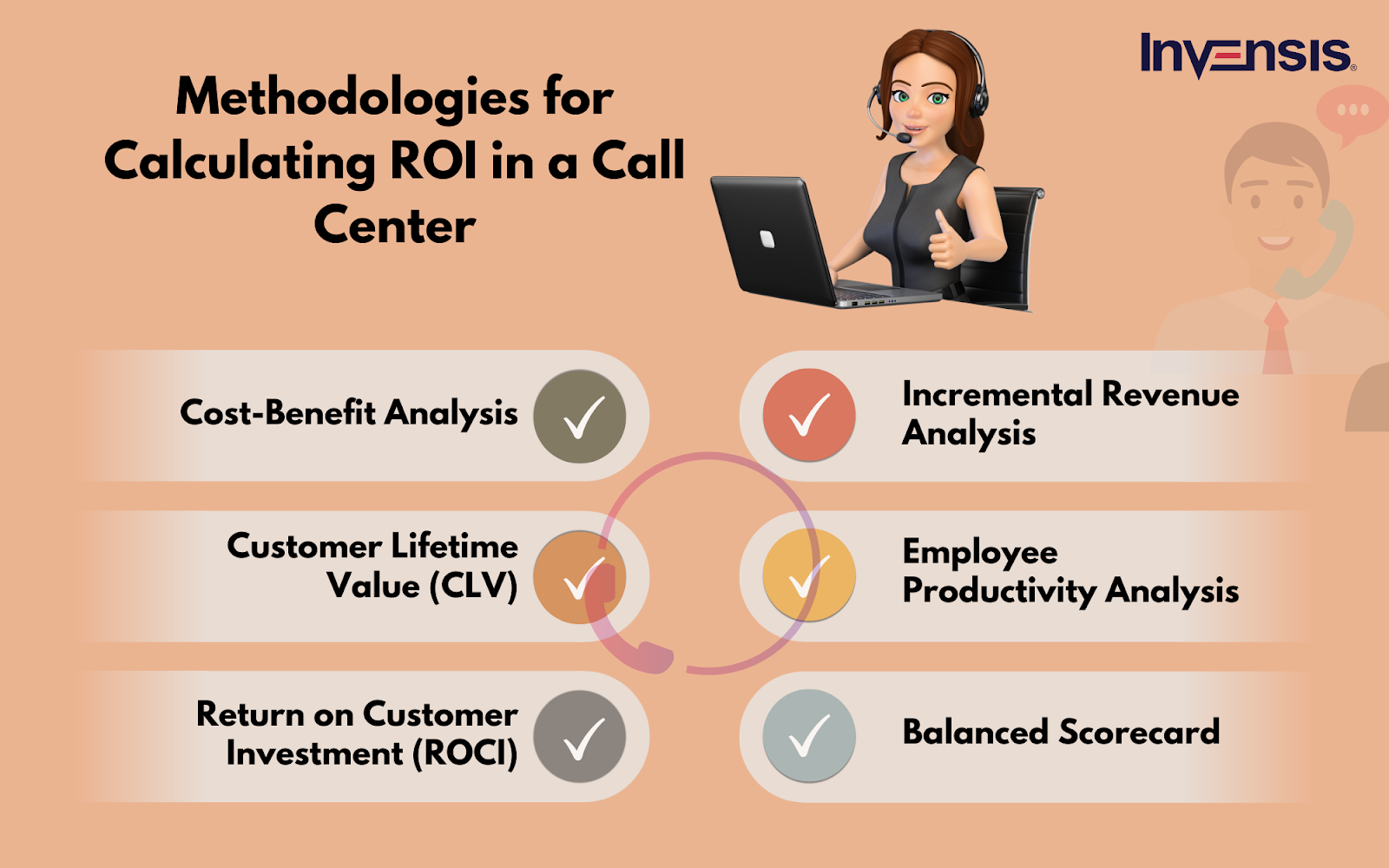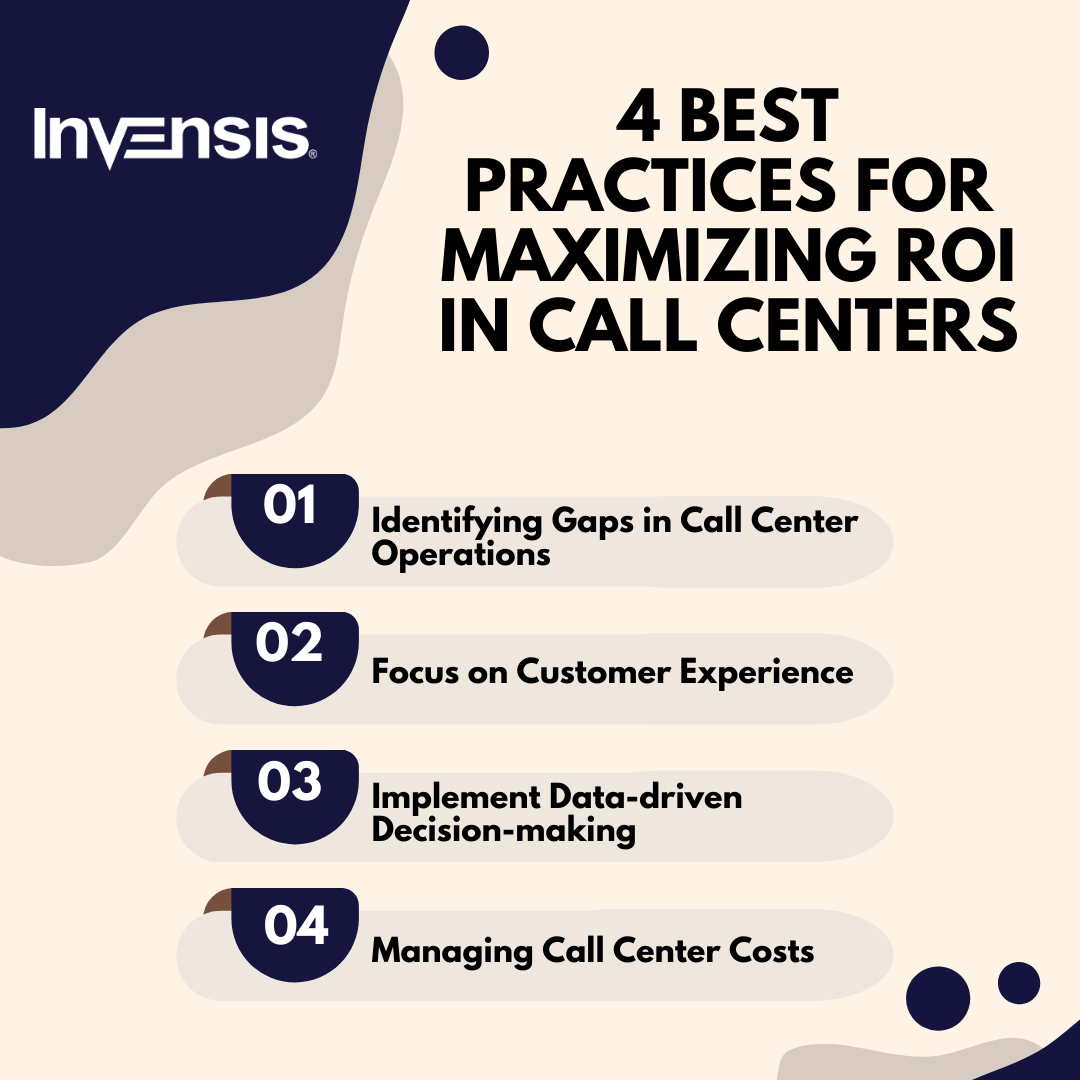
The impact of Return on investment (ROI) on the sustenance of call center operations is huge. ROI analysis helps evaluate the financial performance and effectiveness of call center operations. By measuring key performance indicators (KPIs) such as revenue generated, cost per call, and customer satisfaction, ROI calculations provide insights into the profitability and efficiency of a call center.
Positive ROI demonstrates the effectiveness of the call center in generating revenue, reducing costs, and improving customer satisfaction. This, in turn, justifies investments in technology, training, and process improvements. ROI analysis guides strategic decision-making, resource allocation, and continuous improvement efforts to optimize call center performance and maximize its contribution to the overall business success.
This blog will explore key metrics and techniques to measure the effectiveness of your call center operations and determine their ROI. Additionally, we'll uncover actionable tips and strategies to optimize your call center's performance.
ROI in a call center can be calculated by dividing the total revenue generated by the call center by the cost of operating the call center. The revenue generated can include sales made on calls, customer retention, and customer satisfaction ratings. The cost of operating the call center can include the cost of labor, technology, and facilities.
In the context of call centers, ROI encompasses several key components that contribute to its calculation and assessment.

Calculating ROI in a call center involves various methodologies and approaches. Here are some commonly used methods:


Identifying gaps in call center operations is crucial for improving the organization's return on investment (ROI). A call center plays a vital role in customer support, sales, and support, and any inefficiencies can result in lost revenue and dissatisfied customers. By identifying and addressing these gaps, a company can enhance its operations, optimize resource allocation, and improve its ROI.
To begin, analyzing call center metrics is essential. This involves examining key performance indicators (KPIs) such as average call handling time, first call resolution rate, and customer satisfaction scores. Performance gaps can be identified by comparing these metrics to industry benchmarks and organizational goals.
Furthermore, conducting customer surveys or soliciting feedback can provide valuable insights into areas where the call center may fall short. Understanding customer pain points and areas of dissatisfaction can help pinpoint specific operational gaps.
In addition, leveraging technology can play a significant role in identifying gaps. Call recording and monitoring tools can be used to assess agent performance, identify training needs, and detect patterns of customer complaints or issues. Speech analytics software can analyze customer interactions to uncover trends and identify areas for improvement.
Lastly, involving frontline staff and supervisors in the identification process can yield valuable insights. They have firsthand experience and can provide valuable feedback on potential gaps, bottlenecks, or areas where processes can be streamlined.
The impact of Customer Experience (CX) on improving Return on Investment (ROI) in call centers is a critical consideration for businesses seeking to optimize their operations and drive financial success. Call centers play a crucial role in customer interactions, making it crucial to prioritize CX as a best practice for maximizing ROI.
A research study by Bain & Company found that increasing customer retention rates by 5% can lead to profit increases of 25% to 95% due to additional sales.
Firstly, a positive CX in call centers leads to higher customer satisfaction. Callers are more likely to be satisfied with the solution provided. When they have a smooth and efficient experience, with minimal wait times and effective issue resolution. Satisfied customers are more likely to continue the business with the company and tend to spend more and refer others, thereby increasing sales and revenue.
Secondly, a superior CX in call centers reduces customer churn. Customers who have positive experiences and receive excellent support during their interactions are less likely to switch to competitors. Retaining customers is cost-effective compared to acquiring new ones, as it eliminates the need for additional marketing and acquisition expenses. Consequently, reducing customer churn through improved CX directly contributes to improving ROI.
Moreover, focusing on CX in call centers enhances operational efficiency. By leveraging technologies such as interactive voice response (IVR) systems, intelligent routing, and customer data integration, call centers can streamline processes, reduce call handling times, and improve agent productivity. These improvements lead to cost savings, such as reduced labor costs and increased call capacity, ultimately driving better ROI.
Additionally, by capturing and analyzing customer feedback and call data, call centers can identify areas for improvement and implement targeted training and process enhancements. By addressing specific pain points and improving the skills of call center agents, businesses can enhance the overall CX, resulting in higher customer satisfaction and loyalty, which in turn boosts ROI.
Data-driven decision-making is a powerful strategy to enhance call centers' return on investment (ROI). By leveraging the vast amount of data available within call center operations, organizations can make informed decisions that optimize resources, improve performance, and ultimately increase profitability.
One of the key areas where data-driven decision-making can have a transformative impact is workforce management. By analyzing historical call data, call centers can accurately forecast call volumes and patterns, efficiently scheduling agents based on anticipated demand. This optimization of staffing levels minimizes idle time and reduces customer wait times, leading to improved customer satisfaction and higher ROI.
Moreover, analyzing customer interactions through data-driven techniques such as speech analytics and sentiment analysis provides valuable insights into customer needs, preferences, and pain points. By understanding these patterns, call centers can tailor their business offerings, training programs, and product offerings to meet customer expectations better. This targeted approach increases customer loyalty, reduces customer churn, and boosts ROI.
Data-driven decision-making can also help eliminate process bottlenecks and areas for improvement. Analyzing call handling metrics, such as average handle time and first call resolution rates, allows organizations to pinpoint inefficiencies and implement targeted process improvements. By streamlining operations, call centers can reduce costs, enhance agent productivity, and achieve higher ROI.
Managing call center costs is crucial for optimizing Return on Investment (ROI) and ensuring the profitability of call center operations. By implementing effective cost management strategies, organizations can improve their ROI while maintaining high-quality customer support. Here are some key considerations to enhance call center ROI through cost optimization.
Firstly, analyzing and understanding the call center's cost structure is essential. This includes identifying fixed and variable costs, such as infrastructure, technology, labor, training, and maintenance. Organizations can pinpoint areas where cost-saving measures can be implemented by categorizing and prioritizing these expenses.
One effective strategy is to leverage technology and automation. Implementing advanced call center software, such as interactive voice response (IVR) systems and chatbots, can handle routine customer inquiries, reducing the need for human agents and lowering labor costs. Additionally, workforce management tools can help optimize staff scheduling and improve agent productivity, resulting in better cost efficiency.
Investing in agent training and development is another important aspect. Well-trained agents can handle calls more efficiently, reducing call duration and enhancing customer satisfaction. Continuous training programs can also reduce agent turnover, minimizing recruitment and training costs in the long run.
Regular monitoring and analysis of key performance indicators (KPIs) are essential to identify areas for improvement. Call center managers can identify bottlenecks and implement targeted cost-saving initiatives by tracking metrics such as average handle time, service level, first-call resolution, and customer satisfaction.
Lastly, effective resource allocation is crucial. By aligning staffing levels with call volume patterns, call centers can avoid overstaffing during low-demand periods, minimizing unnecessary costs. Leveraging flexible workforce options, such as remote agents or hiring a partner, can save costs while maintaining service quality.
Optimizing call center costs is a vital step toward maximizing ROI. By leveraging technology, investing in agent training, monitoring KPIs, and adopting efficient resource allocation strategies, organizations can enhance their call center's cost efficiency while delivering exceptional customer experiences.
According to a Deloitte survey, businesses can achieve cost savings of up to 60% by hiring a partner for call center operations.

Several tools and software are available to track and report ROI metrics in a call center. Here are some popular options:
CRM platforms, such as Salesforce, Microsoft Dynamics 365, and Zoho CRM, offer features to track customer interactions, sales data, and customer satisfaction metrics. These systems allow call center managers to analyze customer-related ROI metrics and generate reports.
There are specialized analytics solutions designed specifically for call centers. Examples include Genesys PureAnalytics, NICE Analytics, and Talkdesk Analytics. These tools collect and analyze call center data, including call volumes, wait times, agent performance, and customer feedback, enabling comprehensive ROI reporting.
BI tools like Tableau, Power BI, and QlikView enable call centers to create customizable dashboards and reports. These tools integrate data from various sources, including call center systems and databases, to provide insights into ROI metrics and performance indicators.
Performance management software, such as Calabrio ONE, Verint Monet, and Aspect Workforce Optimization, offers features to track and report on call center agent performance. These systems collect data on metrics like average handle time, first call resolution, and adherence to schedules, providing insights into the ROI of workforce management.
Tools like SurveyMonkey, Qualtrics, and Medallia capture customer feedback and satisfaction data. By collecting feedback after customer interactions, call centers can assess the impact of their solutions on customer satisfaction and loyalty, contributing to ROI measurement.
For smaller call centers or those with limited resources, spreadsheet applications like Microsoft Excel or Google Sheets can manually track and calculate ROI metrics. These tools provide flexibility in creating customized reports and performing calculations based on available data.
According to a study by New Voice Media, 67% of customers have switched to a competitor due to poor customer support.
Delegating the call center function to a trusted partner can help businesses control their ROI in several ways. Firstly, partnering with a specialized call center provider allows businesses to leverage their expertise and resources, resulting in efficient operations and cost savings. It also reduces the need for upfront investments in infrastructure, technology, and human resources, ensuring a better return on investment. Further, call center partners often have established processes, training programs, and quality assurance measures in place, leading to improved customer satisfaction and retention.
Invensis’ leverages its experience and expertise in call center support to boost ROI of call centers. We offer comprehensive solutions to optimize operational efficiency leading to reduced costs, and improved revenue. Our focus on delivering measurable results, will enable you to achieve higher ROI. Contact us now to know more.
Category
.webp)
Business efficiency leads to cost savings, increased productivity etc. Know how to improve business efficiency in this guide.
April 26, 2024
|

Improving goals help businesses elevate their performances. Know how to improve business goals here.
April 26, 2024
|

Customer satisfaction leads to developing strong strong relationships and business growth. Discover how to improve customer satisfaction here.
April 26, 2024
|
